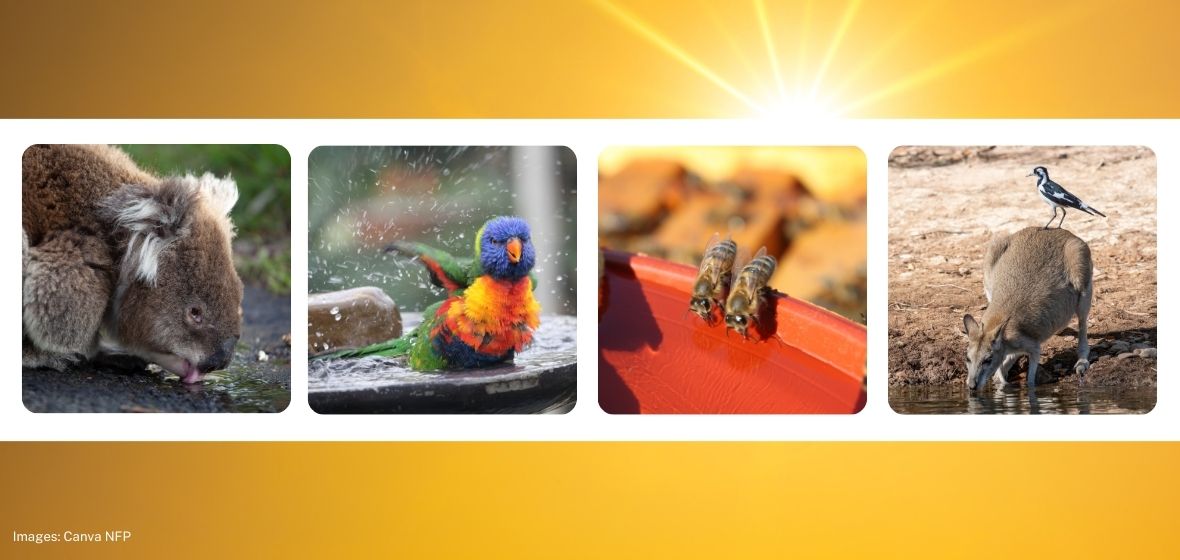Last updated: 11 December 2023
While the primary focus of the Wildlife Preservation Society of Queensland (Wildlife Queensland) is wildlife conservation, we frequently receive enquiries regarding wildlife care. Although we are not a wildlife rescue or care organisation, we deeply appreciate those who contribute their services and support for our local wildlife, especially in the face of the challenges posed by our long, sweltering summers.
In a recent interview with The Community Leader Redlands, Wildlife Queensland Projects Manager, Matt Cecil, and Wildlife Queensland Bayside Branch President, Steve Homewood, provided valuable guidance on caring for our wildlife during the heat. Read their key insights below.
Threats to wildlife during the heat
Summer is here, holidaymakers are gearing up for long trips, and wildlife is stirring. Wildlife Queensland warns that hot summers and increased traffic threaten wildlife, so extra vigilance is in order.
“Dehydration is a major summertime problem for many wild animals,” says Matt Cecil.
“In dry periods, any night-time moisture tends to drain off to the side of roads, encouraging green growth, which in turn entices animals like wallabies to feed, so it’s a good idea to be super-alert behind the wheel, especially at dawn and dusk.
“Animals like koalas and greater gliders get most of their water from leaves; when leaves dry out, the animals suffer. Putting bowls of water around the property can help all thirsty wildlife, but wherever you place them, you need to make sure that animals coming to drink are safe from cats and dogs — managing our pets is a major consideration.”
Creating wildlife havens
That consideration is echoed by Steve Homewood, who asserts that creating shaded, moist environments will attract insects and birds, especially if native trees and shrubs are encouraged.
“Ideally, wherever possible, we should create a haven in our yards, somewhere safe from predators, supplied with shade and water. Shallow dishes close to the ground will serve lizards and the like, and standing birdbaths are ideal for this purpose. Just be sure that water containers don’t pose a risk to the family and keep an eye out for mozzies,” says Steve.
See ‘More Information’ below for additional ways to create safe havens for wildlife.
Road incidents involving wildlife
Any increase in road traffic brings with it an elevated risk of injuries to wildlife, especially during the summer months when many wildlife species, including koalas, reptiles, and kangaroos, are more active and on the move in search of water or moist environments. Dealing with road incidents calls for a combination of compassion and common sense.
“If a marsupial has been killed, there’s always the chance, if it’s a female, that there may be a joey in the pouch,” says Steve.
“If the animal is alive but injured, attending to it could entail risks, from the animal and from traffic — so it’s best to ring one of the animal welfare groups in the area and follow their advice.”
Join us in safeguarding our wildlife this summer — your care makes a world of difference.
View our comprehensive list of wildlife rescue and care organisations.
More information
Explore our blog articles for valuable insights and information on creating safe havens for wildlife:
- How to build a frog pond
- How to build a frog hotel
- How to convert a corner garden into a wildlife wonderland
- Keeping Your Cats and Your Native Wildlife Safe (PDF)
- Bringing the bush to city backyards
- Tips to make pools, fences & roadsides more fauna-friendly

